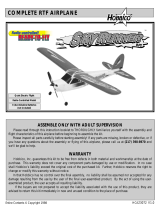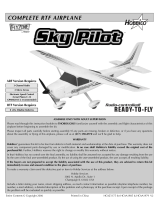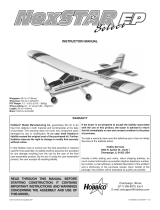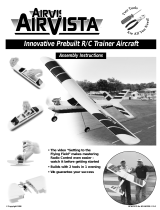
ASSEMBLE ONLY WITH ADULT SUPERVISION
Please read through this instruction booklet to THOROUGHLY familiarize yourself with the assembly and
flight characteristics of this airplane before beginning to assemble the kit.
Please inspect all parts carefully before starting assembly! If any parts are missing, broken or defective, or if
you have any questions about the assembly or flying of this airplane, please call us at (217) 398-8970 and we'll
be glad to help.
WARRANTY
Hobbico, Inc. guarantees this kit to be free from defects in both material and workmanship at the date of
purchase. This warranty does not cover any component parts damaged by use or modification. In no case shall
Hobbico's liability exceed the original cost of the purchased kit. Further, Hobbico reserves the right to change
or modify this warranty without notice.
In that Hobbico has no control over the final assembly, no liability shall be assumed nor accepted for any
damage resulting from the use by the user of the final user-assembled product. By the act of using the
user-assembled product, the user accepts all resulting liability.
If the buyers are not prepared to accept the liability associated with the use of this product, they are advised
to return this kit immediately in new and unused condition to the place of purchase.
C
C
OMPLETE R
OMPLETE R
TF
TF
AIRPLANE
AIRPLANE
Requires 8 (AA) Alkaline
Batteries (not included)
Quiet Electric Flight
Radio-Controlled Model
Entire Contents © Copyright 1999 HCAZ3007 for HCAA2005/2006 V1.0
™
™

Your R/C Action Series plane is not a toy, but rather a
sophisticated, working model that functions very much
like an actual airplane. Because of its realistic
performance, the model, if not assembled and operated
correctly, could possibly cause injury to yourself and
spectators or damage property.
We highly recommend that you get experienced,
knowledgeable help with assembly and during your
first flights, to make your R/C modeling experience
totally enjoyable. You’ll learn faster and avoid risking
your model before you’re truly ready to solo. Your local
hobby shop has information about flying clubs in your
area whose membership includes qualified instructors.
You can also contact the national Academy of Model
Aeronautics (AMA), which has more than 2,500
chartered clubs across the country. Instructor training
programs and insured newcomer training are available
through any one of these clubs.
Contact the AMA at the address or toll-free phone
number below.
Academy of Model Aeronautics
5151 East Memorial Drive
Muncie, IN 47302
(800) 435-9262
Fax: (765) 741-0057
or via the internet at: http://www.modelaircraft.org
1. Assemble the plane according to the instructions. Do
not alter or modify the model. If you make any
modifications, you will void your warranty.
2. Test the operation of the model before each flight to
insure that all equipment is operating properly, and that
the model remains structurally sound.
3. Fly only on calm days (wind speeds less than 7mph)
and in large open areas free of trees, people, buildings
or any other obstacles.
Remember: Take your time and follow the instructions
to end up with a well-built model that is straight,
durable and easy to fly.
The R/C model hobby becomes more and more
enjoyable as your experience grows. Your chances for
success and graduation to higher levels are very good if
you take your time and follow the assembly and flying
instructions carefully and completely.
We hope you enjoy flying your R/C Action Series plane.
Carefully unpack the box and lay out the parts. Check
the parts against the list below. If any parts are damaged
or missing, give us a call at: (217) 398-8970.
Part # Part Name Qty.
❏ 1. Fuselage 1
❏ 2. Wing 1
❏ 3. Stabilizer 1
❏ 4. Tail Piece 1
❏ 5. Landing Gear 1
❏ 6. Landing Gear Cover 1
❏ 7. Propeller 2
❏ 8. Phillips Screwdriver 1
❏ 9. 1mm x 5mm Flat Head Screw 2
❏ 10. 1.5mm x 10mm Sheet Metal Screw 1
❏ 11. 3mm x 18mm Sheet Metal Screw 1
❏ 12. Transmitter 1
❏ 13. NiCd Motor Battery 2
❏ 14. Battery Charger 1
❏ 15. Instructional Video 1
UNPACKING THE BOX
PRECAUTIONS
PROTECT YOUR MODEL, YOURSELF
AND OTHERS.
FOLLOW THIS IMPORTANT SAFETY
PRECAUTION
2

Charge the battery before assembling the airplane. You
will need to use the battery to set up the radio system
during assembly.
Charging the battery pack is safe and easy when you
follow these instructions. Before charging, make sure
that all wires and connectors are in good shape and
properly insulated.
1. Connect the included battery charger to a 110 volt
A/C wall outlet.
2. Remove the battery pack from the box. Plug the
battery into the charger connector. Be careful – the
battery will plug in only one way.
3. Allow the battery to charge for 2 hours using the A/C
wall charger.
4. IMPORTANT! NEVER LEAVE A CHARGING
BATTERY
UNATTENDED.
5. During charging, feel the battery to see if it is starting
to warm up. A warmed up (but not hot!) battery pack is
a sign that it is fully charged. Once the pack is warm,
disconnect it from the charger. Depending on how
much charge was already in the pack, you may have to
disconnect the battery early.
6. After each flight, remove the battery from the airplane
and allow it to cool completely before recharging.
1. Never leave a charging battery unattended.
2. Never let the battery charge until it feels hot. A hot
battery is an overcharged battery. Only let the battery
get warm to the touch.
3. Only use the included charger! A higher rate charger
will charge the pack too quickly and heat up the wires.
4. A properly cared for battery pack will last a long time.
If the battery pack is continually overcharged or charged
at too high of a rate, the pack will not last long.
ATTENTION: The product you have purchased is
powered by a rechargeable battery. The battery is
rechargeable. At the end of its useful life, under various
state and local laws, it may be illegal to dispose of this
battery into the municipal waste system. Check with
your local solid waste officials for details in your area
for recycling options or proper disposal.
BATTERY RECYCLING
SAFETY PRECAUTIONS FOR
CHARGING BATTERIES
CHARGING THE NiCd BATTERY PACK
3

Above is a sketch detailing the layout and function of
the R/C system. It is important to understand the
principles of the system in order to operate your model
correctly.
Charger: The device used to recharge batteries or
battery packs.
Control Horn: The arm which is mounted to a control
surface and attached to a pushrod.
Electronic Speed Control with Auto Cut-off: This unit
controls the speed of the motor. Also it monitors the
battery voltage and turns off the motor so that there will
be enough battery power to operate the radio while you
glide and land the airplane.
Motor: The motor rotates the prop to provide thrust.
NiCd Battery: Rechargeable batteries which are used as
power for the airplane.
Receiver (RX): The radio unit in the airplane which
receives the transmitter signal and relays the control to
the servos.
Servos: The electronic/mechanical device which moves
the control surfaces of the airplane according to the
commands of the transmitter/receiver.
Switch: Turns on the power to the receiver, servos
and motor.
Start Button: With the switch on, pressing the start
button arms the motor. To turn the motor on, move the
throttle stick forward (away from you). To turn the motor
off, move the throttle stick back (toward you).
Transmitter (Tx): This is the hand-held unit that sends
the signal to the receiver. As you move the stick on the
transmitter, the servo in the airplane will react
accordingly.
4
THE RADIO CONTROL SYSTEM

❏ At the front edge of the wing you will notice a small
plastic post. To install the wing, push the post into the
hole on the fuselage. Fasten the wing to the fuselage
with the 3mm x 18mm sheet metal screw (the largest
screw).
❏ Gently work the control horn on the horizontal
stabilizer onto the z-bend. Turn the plane upside-down.
Position the stabilizer on the fuselage. Insert the plastic
post on the front of the tail piece into the hole in the
fuselage. Fasten the tail piece to the fuselage with the
1.5mm x 10mm sheet metal screw ( the medium size
screw).
❏ Insert the wire landing gear into the slot at the front
of the battery cover. Place the landing gear cover over
the wire and fasten it with two 1mm x 5mm flat head
screws (the smallest screws).
INSTALLING THE LANDING GEAR
INSTALLING THE HORIZONTAL
STABILIZER
INSTALLING THE MAIN WING
5

❏ Press the propeller onto the motor shaft. Be sure to
leave a space between the propeller and the front of the
fuselage.
❏ The transmitter that controls your airplane requires
power, in the form of eight “AA” batteries. To install the
batteries, just turn over the transmitter, remove the
battery hatch and install the batteries. Reinstall the
battery hatch and check the LEDs on the front of the
transmitter. Like traffic lights, green means “GO!”
However, if the red LED is glowing, you need to install
fresh batteries.
❏ This is also a good time to make sure that your radio’s
servo reversing switches are correctly set. Both the
switch for the throttle servo and the rudder servo should
be on “NOR” (normal) setting.
❏ After the NiCd battery is charged, install it in the
plane. Remove the battery hatch and simply attach the
battery to the connector inside your plane. This battery
will provide power to all the electronics in your plane.
HOW DOES THE AIRPLANE WORK?
Your transmitter controls the airspeed and direction. You
can go as slow or as fast as you want, but remember: the
faster you fly, the faster your battery power is used up.
When battery power gets too low, the “Auto Cut-Off”
feature of the speed control provides an extra degree of
insurance. It reacts to low power by cutting power to the
INSTALLING THE BATTERY PACK
TRANSMITTER SET UP
INSTALLING THE TRANSMITTER
BATTERIES
INSTALLING THE PROPELLER
6

motor, in effect saving power for the receiver. That way,
your airplane goes into a glide and you stay in control
until you land.
CHOOSE A GOOD FLYING SITE
It’s best to fly on calm days, when there’s little or no
wind. Also, find an area clear of trees, power lines and
other structures. A park or schoolyard is good, if not
crowded; a flying field for R/C airplanes is best. Don’t
fly around groups of people, especially children. The
moving prop can be dangerous.
CHECK YOUR PLANE FOR LEVEL FLIGHT
It’s easy to do. With the motor off, hold your airplane by
the fuselage and gently toss it straight out into the wind.
It should fly straight and level before floating gently to
the ground.
If your plane doesn’t fly level, you’ll need to adjust the
elevator. This is the movable part of the horizontal
stabilizer. To adjust the elevator, simply loosen the
screw that holds the control wire, make a small
adjustment up or down, re-tighten and test it again.
A. If your plane climbs and stops in mid-air before
gliding to the ground...
You need to adjust the elevator slightly downward.
B. If your plane dives when you launch it...
You need to adjust the elevator slightly upward.
C. If your plane flies level then slowly glides to the
ground...
Your airplane is ready to fly.
It may take several tries to make your plane fly level. The
best way to do it is to make very small adjustments to
the elevator (1/16" or less), and then test the effect of
the change.
CHECK THE SPINNER AND PROPELLER
After test gliding the airplane, make sure the spinner
does not rub against the fuselage. You will need to check
it after every flight.
PREPARE FOR TAKEOFF
1. Find an open area free of buildings, trees, power lines
and people.
2. For your first few flights, fly only in winds of no more
than 3 miles per hour. After you are comfortable with
the airplane, you can fly in winds that are no more than
7 miles per hour. If flown in stronger winds, the plane
may be blown down wind and not have enough power
to get back to you.
3. Make sure the NiCd battery is fully charged and that
the transmitter has good “AA” batteries installed.
4. If others are flying in the same area, make sure that
they are not using the same channel radio system you
are. The front of your transmitter has a tag with a color
and number (for example 27.145). This is the frequency
you are using.
5. Range check your radio before each flight. Switch on
the transmitter and then the receiver. Do not push the
motor start button during the radio range check. With
the antenna collapsed, walk 50 feet away from the
airplane. Move the rudder control stick, checking that
the rudder moves. If you still have control over the
airplane, it is safe to extend the antenna and fly the
airplane.
7

FLYING THE AIRPLANE
1. First, turn your transmitter power switch “ON.” This
immediately puts you in control. Be sure your throttle
stick is back (pulled all the way towards you).
2. Now pick up the airplane and switch the airplane on.
3. Press the start button. Caution: keep your hands
behind the prop.
4. Move the throttle stick forward (moved away from
you). The propeller will start to turn. The farther you
move the stick, the faster the propeller will turn.
5. With the throttle stick moved fully forward (full
throttle), hand launch your airplane into the wind, at a
slight upward angle.
6. Allow the airplane to climb a few seconds before
turning it.
7. The right stick is your rudder control. When your
plane is moving away from you, moving the rudder stick
to the left will make your plane turn to the left. Moving
the rudder stick to the right will make your plane
turn right.
8. When the plane is coming toward you, moving the
rudder stick left still causes left rudder, but your plane
goes to your right. In short, you have to reverse the way
you control the rudder. A good way to familiarize
yourself with the controls is when the plane is coming
toward you, turn your body so that you are facing the
same direction the plane is going, looking over your
shoulder at the plane. Now when you move the rudder
stick left the plane will go left.
9. When turning, the plane will lose some altitude. The
sharper the plane turns, the more altitude it will lose. Try
to make gentle turns.
10. Don’t let the airplane get too far away from you. The
farther away it is, the harder it is to see what the plane
is doing.
LANDING
Once the motor cuts off, prepare to land. Always land
as straight into the wind as possible. You may need to
circle the plane a few times to gradually descend to the
ground.
AFTER THE FLIGHT
Switch the airplane then the transmitter off. Unplug and
remove the NiCd battery. Allow the NiCd battery to cool
before recharging. Check the plane to make sure
nothing has come loose.
STRUCTURE
In the unfortunate event that you may damage your
airplane, repairs are fairly simple to make yourself. If
there are any cracks in the wing or fuselage, apply
6-minute epoxy to the broken area and hold together
with clear packaging tape. Let the glue cure, leaving the
tape in place for added strength.
After all repairs are completed, check that the prop is
not hitting the fuselage or is damaged.
We hope this short instruction manual and the included
video on flying helps you get off to a great start in
R/C flying.
Replacement parts for your Zoom/Sun Pilot
Sun Pilot Parts
Stock # Description
HCAA3251 Complete Wing Set
HCAA3252 Complete Tail Set
HCAA3253 Fuselage
HCAA3254 Decal Set
HCAM7027 Battery
HCAG1020 Motor
HCAM7028 Electronic Speed Control
Zoom Pilot Parts
Stock # Description
HCAA3260 Complete Wing Set
HCAA3261 Complete Tail Set
HCAA3262 Fuselage
HCAA3263 Decal Set
HCAM7027 Battery
HCAG1020 Motor
HCAM7028 Electronic Speed Control
PARTS LIST
/







